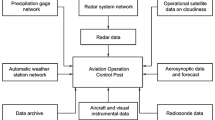Abstract
The description is given of the modern conception and of technical means to carry out the weather modification activities in megalopolises using the active influencing methods. The main objective of these activities is the cloud dissipation and the decrease or cessation of precipitation on the territory under protection. Four influencing methods are commonly used depending on the synoptic situation. To carry out the meteorological protection activities, the airplanes are used equipped with the measuring equipment necessary to execute the influencing, the “land-aircraft-land” system of the radio data traffic and the cloud seeding means. The liquid nitrogen, solid carbonic acid, silver iodide, and coarse-dispersion powder are used as the cloud seeding reagents. To control the aviation activities and the results of cloud seeding, the ground automated radar meteorological complexes are used.
Similar content being viewed by others
References
D. R. Aisin, S. M. Gal’perin, V. N. Kozlov, and G. G. Shchukin, “Active Influencing on the Clouds and Precipitation in St. Petersburg during the Summit of Heads of States and Governments of G8,” Trudy GGO, No. 556 (2007) [Trans. Main Geophysical Observatory, No. 556 (2007)].
V. P. Belyaev, G. P. Beryulev, M. P. Vlasyuk, et al., “A Case Study of Cloud Seeding over Moscow on May 9, 1995,” Meteorol. Gidrol., No. 5 (1996) [Russ. Meteorol. Hydrol., No. 5 (1996)].
V. P. Belyaev, L. P. Zatsepina, L. B. Zontov, et al., “Some Results of Experiments on the Dissipation of Multicell Convective Clouds,” Trudy TsAO, No. 164 (1987) [Trans. Central Aerological Observatory, No. 164 (1987)].
G. P. Beryulev, I. I. Burtsev, N. K. Vinnichenko, et al., “Comparison of Field and Numerical Experiments on Dispersal of Stratiform Clouds over Moscow on November 7, 1986,” Meteorol. Gidrol., No. 12 (1988) [Sov. Meteorol. Hydrol., No. 12 (1988)].
G. P. Beryulev, L. P. Zatsepina, L. B. Zontov, et al., “A Case Study of Artificial Precipitation Modification Activities for the Purpose of Weakening Aftermath of the Accident at Chernobyl Nuclear Power Plant,” in Proceedings of the All-Union Conference on Active Influencing (Gidrometeoizdat, Leningrad, 1990).
N. I. Wul’fson and B. P. Cherenkova, “Influencing on Convective Clouds by Artificially Created Downward Motions,” Trudy IPG, No. 12 (1970) [Trans. Inst. Applied Geophysics, No. 12 (1970)].
I. I. Gaivoronskii, L. P. Zatsepina, and Yu. A. Seregin, “The Results of Influencing Experiments on Convective Clouds,” Izv. Akad. Nauk, Fiz. Atmos. Okeana, No. 3, 6 (1970) [Izv., Atmos. Oceanic Phys., No. 3, 6 (1970)].
I. V. Grits’kiv, I. V. Litvinov, B. M. Matkovskii, et al., “The Experience of Cloud Seeding in the Central Region of the European Territory of the Soviet Union for the Purpose of Precipitation Redistribution,” Trudy IEM, No. 3 (1968) [Trans. Inst. Experimental Meteorology, No. 3 (1968)].
A. Dennis, Weather Modification by Cloud Seeding (Mir, Moscow, 1983) [in Russian].
Yu. A. Dovgalyuk, E. V. Orenburgskaya, A. M. Pirnach, et al., “Analysis of Cloud Modification Activities to Prevent Precipitation in Leningrad (a Case Study of November 7, 1988),” Meteorol. Gidrol., No. 2 (1998) [Russ. Meteorol. Hydrol., No. 2 (1998)].
I. V. Litvinov, “Precipitation Redistribution when Influencing the Clouds with Coolants,” Meteorol. Gidrol., No. 9 (1967).
G. G. Shchukin, V. N. Kozlov, V. D. Stepanenko, et al., “A Seeding of Cloud Systems for the Purpose of the Provision of Favorable Weather Conditions during the Celebration of the 300th Anniversary of St. Petersburg on May 30–31, 2003,” Trudy NITs DZA, No. 5 (2004) [Trans. Res. Center Remote Atmos. Sounding, No. 5 (2004)].
A. I. Bedritsky and A. A. Chernikov, “Cloud Seeding to Protect Moscow from Rain on 9 May 1995,” WMO Bulletin, No. 1, 45 (1996).
R. Bruinjes, “A Review of Cloud Seeding Experiments to Enhance Precipitation and Some New Prospects,” Bull. Amer. Meteorol. Soc., No. 5, 80 (1999).
M. Garstang et al., “Weather Modification: Finding Common Ground,” Bull. Amer. Meteorol. Soc., No. 5, 86 (2005).
B. P. Koloskov, V. P. Korneev, V. V. Petrov, et al., “Cloud Seeding Operation to Modify Weather Conditions over Cities: 2003–2006,” in Proceedings of the Ninth WMO Scientific Conference on Weather Modifications, 2007, Turkey, WMP-No. 44.
V. V. Petrov, O. G. Egorov, A. M. Mel’nik, et al., “Data Transmission System “Land-Aircraft-Land”,” in Proceedings of the Ninth WMO Scientific Conference on Weather Modifications, 2007, Turkey, WMP-No. 44.
Author information
Authors and Affiliations
Additional information
Original Russian Text © B.P. Koloskov, V.P. Korneev, V.V. Petrov, G.P. Beryulev, B.G. Danelyan, 2010, published in Meteorologiya i Gidrologiya, 2010, No. 8, pp. 21–32.
About this article
Cite this article
Koloskov, B.P., Korneev, V.P., Petrov, V.V. et al. Modern conception of meteorological protection of megalopolises using cloud seeding methods. Russ. Meteorol. Hydrol. 35, 515–523 (2010). https://doi.org/10.3103/S1068373910080029
Received:
Published:
Issue Date:
DOI: https://doi.org/10.3103/S1068373910080029




